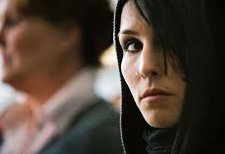
Documentary Pink Saris
On International Women's Day you'll see a lot of shocking stories about violence against women and a few others asking why we don't discuss this subject during the rest of the year. In fact we do, in that our newspapers are always full of stories about women being killed, raped, beaten, or simply going missing, but they're so much a part of day to day life that we tend to tune them out. Where they are more notably absent is in fiction, in which they have traditionally been most likely to emerge as sub-plots providing motivation for male characters. Now that is starting to change and a new generation of filmmakers is exploring these issues from a female perspective.
The emergence of these stories in film is more important than it might initially appear to be. It can be read as a symbol of social change - savvy film investors don't put their money into projects unless they're sure there's an audience out there. It's also important because of the social impact it can have. In the UK, the average person now takes in substantially more films than books in the course of a year. Films inspire a very immediate, emotional response that we don't always get when reading. Even if we hate a film with a subject like this, we're likely to spend some time thinking about it. Films get past the usual mechanisms that enable us to tune these stories out. This effect may only be temporary - if they become commonplace, we might stop noticing - but that makes what is happening at the moment all the more important.
There have, of course, always been documentaries out there examining this kind of issue, though increasingly the ones we see in the UK have tended to focus on situations in other countries, enabling us to feel duly concerned without facing up to our own social problems. This isn't about deliberate selection so much as it's due to a growth in discussion about such issues in Africa and Asia, with impressive work like Pink Saris and Rough Aunties emerging as a result. It's easier to draw in an audience with a more dramatic subject and this has perhaps added to the imbalance. Stories about honour killings, forced marriages and rape used as a weapon of war make compelling viewing but it's more difficult to address subtler issues such as the ongoing effect on individuals of exposure to lower level acts of aggression. This is where fiction is better equipped to handle the task.
 |
| Julia Roberts in Erin Brockovich |
Although it often finds itself beneath the critical radar, another important area of film when it comes to strong roles for women is the horror genre. horror also tends to be ahead of the pack when it comes to responding to social change, in part because it is so prolific and in part because horror films are often made quickly, on low budgets, so they can be more culturally responsive with fewer risks. There has, of course, been a long tradition in horror of exploitation films about the revenge of abused women, the most notorious being I Spit On Your Grave, but the genre has also featured some surprisingly realistic performances by women as victims of violence, such as those in Baise-Moi and Last House On The Left (which draws, of course, on Ingmar Bergman's The Virgin Spring). Often the schlocky comedy in these films works effectively as a counterpoint to the real horror of the acts of violence suffered by these characters.
 |
| All The Boys Love Mandy Lane |
That anger is the key to the shift in how films are dealing with this difficult subject. It was the missing ingredient in the previous generation of revenge films, which were always cold blooded and calculating, perhaps due to the assumption that a woman could never win in a spontaneous fight with a man. There were occasional hints of it, however, in characters like Sigourney Weaver's Ripley who, in the first Alien film, is shown to be gradually more infuriated by the dismissive behaviour toward her of her male crew members are subsequently by an attempt to kill her that is highly sexual in nature. It is partly this anger that feeds into her rage against the monsters she goes on to face, and the subject is returned to in David Fincher's thoughtful, if flawed, second sequel.
Perhaps the most influential films of the 21st century, in this regard, have been the Millenium films based on Stieg Larsson's bestselling novels. Again, adaptation from an existing story has perhaps made it possible for these celluloid tales to be developed where nobody would have dared to invest otherwise. The central female character, Girl With The Dragon Tattoo Lisbeth Salander, is presented as a survivor of an abusive childhood situation who has learned to react violently to others' aggression. What's significant, though, is that her past remains in the background for much of the first film, so that her actions have to be assessed on their own merits; and that, whilst her past experiences might explain her reactions to aggression, they don't explain the frequency with which she encounters that aggression itself. Though it might seem excessive, this (the film's central mystery, not directly related, aside) is entirely consistent with the statistical evidence on what women experience during their lives; many will not be as unlucky as Lisbeth, but for many it will be worse. For others a minor assault in a train station may be overlooked, considered as just one of those things one has to put up with in life. The film aims to shock us out of that sensibility. Lisbeth's anger is not her schtick, a simple character selling point; it's a question. Why don't more people react the way she does?
 |
| Girl With The Dragon Tattoo |
If this message was diluted somewhat by the Millenium films' tendency to become fanciful, a much more down to Earth version is presented in Pernilla August's Beyond, which uses the same actresses (Noomi Rapace with Tehilla Blad as her younger self) to tell the story of a woman coming to terms with her memories of childhood in home where alcoholism and domestic violence were part of daily life. Equally bleak and without the relief of action sequences, it's a film which many fill find hard to watch, but it's very effective in demonstrating the lifelong effect that witnessing violence, as well as suffering it, can have. By placing it so clearly in the domestic context and showing it from a female perspective (unlike say, Gary Oldman's very effective but differently slanted Nil By Mouth) it reminds us just how much a part of ordinary life this sort of situation is for many people. Is it because we are so used to its existence in the background of our lives that we have failed to see the drama in it, and thus to realise its dramatic potential onscreen?
There has been another historic difficulty with depicting realistic reactions of women toward violence onscreen, and that has been the existence of cinematic taboos over the presentation of violence committed by women (outside of heavily stylised action movies) and women's anger. Women in cinema get to lose their tempers over sexual infidelity, the mistreatment of children and similar subjects traditionally accepted as part of their sphere, but rarely over violence and rarely in an aggressive way not tempered by comedy. In reality, of course, women's responses differ widely, but limiting onscreen narratives in this way has silenced an important voice. It is a voice that is now beginning to be heard and what it has to say about the future of cinema, and its relationship with wider culture, promises to be interesting.





















